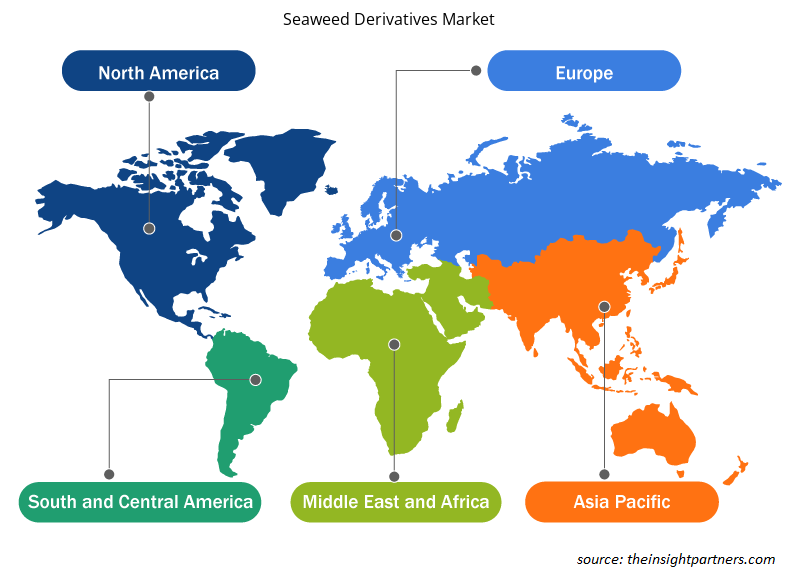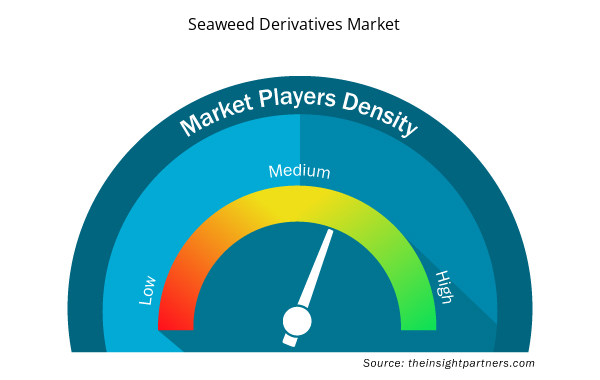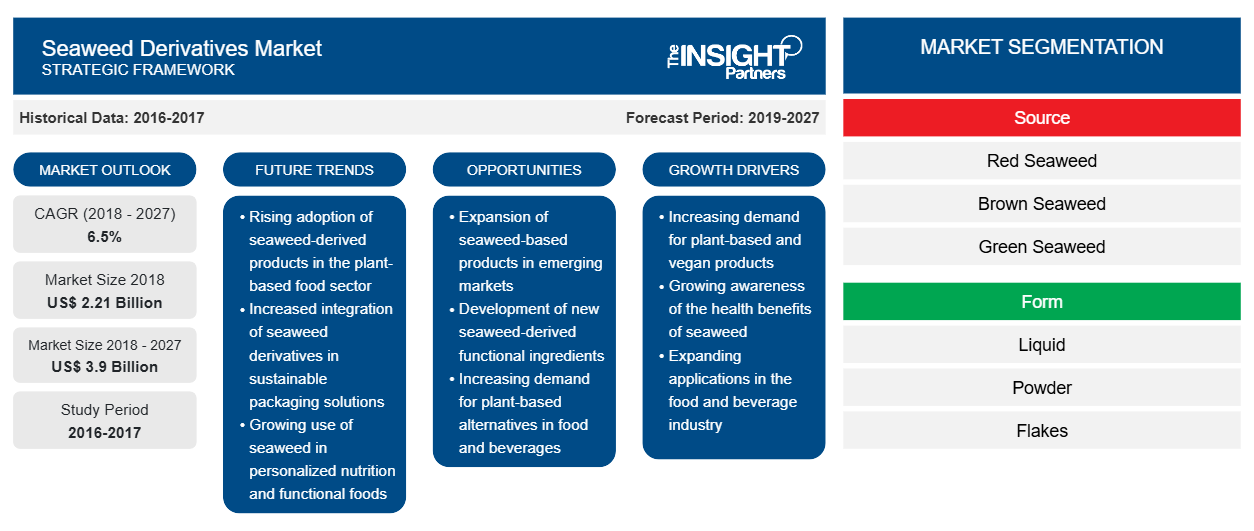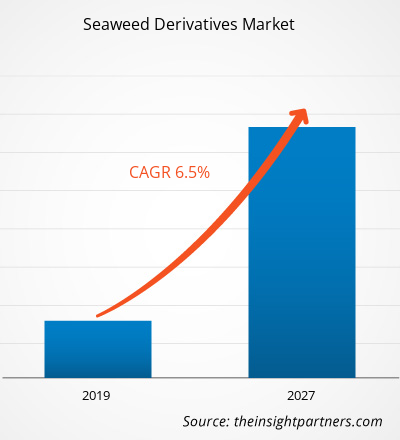Der Markt für Meeresalgen-Derivate wurde im Jahr 2018 auf 2.210,35 Millionen US-Dollar geschätzt und soll bis 2027 einen Wert von 3.903,91 Millionen US-Dollar erreichen; von 2019 bis 2027 dürfte er mit einer durchschnittlichen jährlichen Wachstumsrate von 6,5 % wachsen.
Meeresalgen sind im Wesentlichen rote, braune und grüne Meeresmikroalgen, deren Extrakte aufgrund ihrer pflanzenwachstumsfördernden Wirkung im Gartenbau verwendet werden. Zu den chemischen Derivaten von Meeresalgen gehören unter anderem Fettsäuren und Vitamine, Mineralstoffe, Phytoharmonien und komplexe Polysaccharide. Zu den wichtigsten Derivaten von Meeresalgen gehören Alginate, Carrageene und Agare. Alginate werden größtenteils aus Braunalgen gewonnen, während Carrageene und Agare größtenteils aus Rotalgen gewonnen werden. Alginate, Carrageene und Agare werden unter anderem zunehmend in der Lebensmittel- und Getränkeindustrie, der Tierfutterindustrie und in der Landwirtschaft verwendet.
Im Jahr 2018 hatte der asiatisch-pazifische Raum den größten Anteil am globalen Markt für Algenderivate , gefolgt von Europa und Nordamerika. Die steigende Nachfrage aus der Lebensmittel- und Getränkeindustrie, der Tierfutterindustrie und der Landwirtschaft treibt den Markt im asiatisch-pazifischen Raum vor allem an. China, Südkorea und Japan sind die größten Produzenten und Konsumenten von Algenderivaten im asiatisch-pazifischen Raum. Der Markt wird vor allem durch die breitere Anwendung von Algenderivaten in der Lebensmittel- und Getränkeindustrie getrieben. Sie werden zunehmend in Düngemitteln verwendet, was den Ernteertrag verbessert und die Pflanzen kräftiger macht, was wiederum die Schädlingsresistenz stärkt. Das steigende Bewusstsein der Verbraucher für die gesundheitlichen Vorteile von Algenderivaten beflügelt den Algenmarkt enorm. Auch die steigende Nachfrage nach Bio-Lebensmitteln treibt das Wachstum des Marktes für Algenderivate an. Das geringere Bewusstsein der Landwirte für die Gewinnung von Algen hemmt das Marktwachstum für Algenderivate.
Der COVID-19-Ausbruch begann im Dezember 2019 in Wuhan (China) und hat sich seitdem rasant über den Globus verbreitet. China, Italien, Iran, Spanien, die Republik Korea, Frankreich, Deutschland und die USA gehörten im Hinblick auf die Zahl der bestätigten Fälle und der gemeldeten Todesfälle (Stand: März 2020) zu den am schlimmsten betroffenen Ländern. Der COVID-19-Ausbruch hat aufgrund von Lockdowns, Reiseverboten und Geschäftsschließungen die Wirtschaft und Industrie in zahlreichen Ländern beeinträchtigt. Die globale Lebensmittel- und Getränkeindustrie ist eine der wichtigsten Branchen, die infolge dieses Ausbruchs unter schwerwiegenden Störungen wie Lieferkettenunterbrechungen, Absagen von Technologieveranstaltungen und Büroschließungen leidet. China beispielsweise ist das globale Zentrum der Produktion und der größte Rohstofflieferant für zahlreiche Branchen. Der allgemeine Marktzusammenbruch aufgrund von COVID-19 wirkt sich auch auf das Marktwachstum von Algenderivaten aus, da Fabriken geschlossen werden, Lieferkettenhemmnisse auftreten und die Weltwirtschaft einen Abschwung erlebt.
Passen Sie diesen Bericht Ihren Anforderungen an
Sie erhalten kostenlose Anpassungen an jedem Bericht, einschließlich Teilen dieses Berichts oder einer Analyse auf Länderebene, eines Excel-Datenpakets sowie tolle Angebote und Rabatte für Start-ups und Universitäten.
- Holen Sie sich die wichtigsten Markttrends aus diesem Bericht.Dieses KOSTENLOSE Beispiel umfasst eine Datenanalyse von Markttrends bis hin zu Schätzungen und Prognosen.
Markteinblicke
Die steigende Nachfrage aus der Lebensmittel- und Getränkeindustrie hat den Markt für Algenderivate weltweit begünstigt
Algenderivate wie Agar, Alginate und Carrageene werden in zahlreichen Lebensmitteln und Getränken verwendet. Diese Derivate kommen in einer Vielzahl von Lebensmitteln und Getränken zum Einsatz, beispielsweise in Eiscreme, Sirup, Aufschnitt, Babynahrung, Mandelmilch, Schlagsahne, Schokoriegeln, Schokoladenmilch, Kaffeegetränken (z. B. Eiskaffee und Kaffeegetränke auf Sojabasis), Kaffeeweißer, Ricotta, Joghurt, Hüttenkäse und Sauerrahm. Carrageene werden als Verdickungsmittel in Puddings, Schokoladenmilch, Kaugummi, Marmelade und Gelees verwendet. Darüber hinaus reduzieren Carrageene die Abfallmenge, indem sie die Haltbarkeit von Lebensmitteln ohne Qualitätsverlust verlängern. Verschiedene Lebensmittel wie Mayonnaise und Salatdressing würden sich ohne die Hilfe eines Stabilisators trennen. Daher wird Carrageen als Stabilisator in Mayonnaise und Salatdressing verwendet. Daher fördert ein breites Anwendungsspektrum von Algenderivaten in der Lebensmittel- und Getränkeindustrie das Wachstum des Marktes für Algenderivate weltweit.
Quelle Einblicke
Basierend auf der Quelle ist der Markt für Algenderivate in Rotalgen, Braunalgen und Grünalgen unterteilt. Im Jahr 2018 hatte das Rotalgensegment den größten Anteil am weltweiten Markt für Algenderivate. Rotalgen haben tendenziell den höchsten Proteingehalt, der für ihre rote Farbe verantwortlich ist. Obwohl Rotalgen in seichten Gewässern vorkommen, können sie tiefem Wasser und schlechten Lichtverhältnissen standhalten. Diese Faktoren fördern das Wachstum des Marktes für Rotalgenderivate.
FormInsights
Basierend auf der Form ist der Markt für Algenderivate in Flüssigkeiten, Pulver und Flocken unterteilt. Im Jahr 2018 hatte das flüssige Segment den größten Anteil am weltweiten Markt für Algenderivate; es wird jedoch erwartet, dass das Pulversegment im Prognosezeitraum die höchste Wachstumsrate verzeichnet. Flüssige Derivate aus Braunalgen werden für den Einsatz im Gartenbau und in der Landwirtschaft vermarktet. Die flüssigen Algenderivate werden in hohen Verdünnungsraten verwendet, was dazu führt, dass auf der gegebenen Fläche nur minimale Materialmengen aufgetragen werden. Die Wirkstoffe in flüssigen Algenderivaten können solche niedrigen Temperaturen beeinflussen.
End-UseInsights
Basierend auf der Endverwendung ist der Markt für Algenderivate in Lebensmittel und Getränke, Agrarprodukte, Futtermittelzusätze, Arzneimittel und andere unterteilt. Im Jahr 2018 hatte das Segment Lebensmittel und Getränke den größten Anteil am globalen Markt für Algenderivate; das Segment Futtermittelzusätze dürfte jedoch im Prognosezeitraum die höchste Wachstumsrate verzeichnen. Algenderivate wie Alginate werden häufig in Backwaren, Süßigkeiten, Milchprodukten, Salatdressings, Eiscremes, Cremes und Gelees sowie in Wurst, Fleischverarbeitung und Fisch verwendet. Sie werden auch zur Klärung von Bier und Wein verwendet. Alginate sind vollständig organisch und eine für die Verwendung in Lebensmitteln unbedenkliche Substanz. Darüber hinaus können Alginate eine Lösung verdicken, wenn sie in Wasser aufgelöst werden. Darüber hinaus können Alginate Gele bilden, wenn sie einer Calciumsalzlösung zugesetzt werden. Daher werden Alginate hauptsächlich in Salatdressings und Mayonnaise verwendet.
Regionale Einblicke in den Markt für Meeresalgenderivate
Die regionalen Trends und Faktoren, die den Markt für Meeresalgenderivate im Prognosezeitraum beeinflussen, wurden von den Analysten von Insight Partners ausführlich erläutert. In diesem Abschnitt werden auch die Marktsegmente und die Geografie von Meeresalgenderivaten in Nordamerika, Europa, im asiatisch-pazifischen Raum, im Nahen Osten und Afrika sowie in Süd- und Mittelamerika erörtert.

- Erhalten Sie regionale Daten zum Markt für Meeresalgenderivate
Umfang des Marktberichts über Meeresalgenderivate
| Berichtsattribut | Details |
|---|---|
| Marktgröße im Jahr 2018 | 2,21 Milliarden US-Dollar |
| Marktgröße bis 2027 | 3,9 Milliarden US-Dollar |
| Globale CAGR (2018 - 2027) | 6,5 % |
| Historische Daten | 2016-2017 |
| Prognosezeitraum | 2019–2027 |
| Abgedeckte Segmente | Nach Quelle
|
| Abgedeckte Regionen und Länder | Nordamerika
|
| Marktführer und wichtige Unternehmensprofile |
|
Marktteilnehmerdichte: Der Einfluss auf die Geschäftsdynamik
Der Markt für Meeresalgenderivate wächst rasant, angetrieben durch die steigende Nachfrage der Endverbraucher aufgrund von Faktoren wie sich entwickelnden Verbraucherpräferenzen, technologischen Fortschritten und einem größeren Bewusstsein für die Vorteile des Produkts. Mit steigender Nachfrage erweitern Unternehmen ihr Angebot, entwickeln Innovationen, um die Bedürfnisse der Verbraucher zu erfüllen, und nutzen neue Trends, was das Marktwachstum weiter ankurbelt.
Die Marktteilnehmerdichte bezieht sich auf die Verteilung von Firmen oder Unternehmen, die in einem bestimmten Markt oder einer bestimmten Branche tätig sind. Sie gibt an, wie viele Wettbewerber (Marktteilnehmer) in einem bestimmten Marktraum im Verhältnis zu seiner Größe oder seinem gesamten Marktwert präsent sind.
Die wichtigsten auf dem Markt für Meeresalgen-Derivate tätigen Unternehmen sind:
- W Hydrocolloids, Inc.
- KIMICA Corporation
- DuPont de Nemours, Inc.
- Gelymar SA
- CP Kelco
Haftungsausschluss : Die oben aufgeführten Unternehmen sind nicht in einer bestimmten Reihenfolge aufgeführt.

- Überblick über die wichtigsten Akteure auf dem Markt für Meeresalgen-Derivate
Globaler Markt für Meeresalgenderivate – nach Quelle
- Rote Algen
- Brauner Seetang
- Grüne Algen
Globaler Markt für Meeresalgenderivate – nach Form
- Flüssig
- Pulver
- Flocken
Globaler Markt für Meeresalgen-Derivate – nach Endverwendung
- Essen und Trinken
- Landwirtschaftliche Produkte
- Futterzusätze
- Pharmazeutika
- Andere Endverwendung
Firmenprofile
- W Hydrocolloids, Inc.
- KIMICA Corporation
- DuPont de Nemours, Inc.
- Gelymar SA
- CP Kelco
- ALGEN
- Compañía Española de Algas Marinas, SA
- Cargill, Incorporated
- ARTHUR BRANWELL & CO
- AGARMEX, SA DE CV
- Historische Analyse (2 Jahre), Basisjahr, Prognose (7 Jahre) mit CAGR
- PEST- und SWOT-Analyse
- Marktgröße Wert/Volumen – Global, Regional, Land
- Branche und Wettbewerbsumfeld
- Excel-Datensatz



Report Coverage
Revenue forecast, Company Analysis, Industry landscape, Growth factors, and Trends

Segment Covered
This text is related
to segments covered.

Regional Scope
North America, Europe, Asia Pacific, Middle East & Africa, South & Central America

Country Scope
This text is related
to country scope.
Häufig gestellte Fragen
In 2018, the seaweed derivatives market was predominant by Asia-Pacific at the global level.Rising concerns about healthy food due to the overweight and obese population as well as rising prevalence of chronic diseases, such as diabetes, hypertension, cardiac issues, and orthopedic diseases, are a few more factors driving the seaweed derivatives market in this region.. Growing awareness about the health benefits and increasing seaweed derivatives usage in the personal care sector is driving the market growth in the region.People in China, Japan, and South Korea have cultivated and harvested seaweed for food and other industrial uses for hundreds of years. Seaweed derivatives are used in textile ink for more than 1000 years. The Asia Pacific has become a lucrative region, which has witnessed an increase in the investment among the manufactures related to several industries such as food and beverage, personal care, and pharmaceutical, amongst others. The growth of these industries is positively expected to expand the demand for seaweed derivatives products in the region.
Among all three segments of source, the red seaweedsegment has led the market in 2018 and is expected to be the dominant segment in the near future.The red seaweed is large branched plants or bushy growths on shellfish and rocks. It makes up the largest group of algae in the plant kingdom, with more species compared to green and brown seaweeds. The main Form of red seaweed is as a source of two hydrocolloids, namely, agar and carrageenan, and the second one is as a source of food. Red seaweed is a marine plant exclusively. Red seaweed tends to possess the highest protein levels, which are responsible for its red color.
The major players operating in the globalseaweed derivativesmarketareW Hydrocolloids, Inc., KIMICA Corporation, DuPont de Nemours, Inc., Gelymar S.A., CP Kelco, Algaia, and Cargill Incorporated, CompañÃa Española de Algas Marinas, S.A., Arthur Branwell & Co., Agarmex, S.A. DE C.V., and among many others.
Trends and growth analysis reports related to Consumer Goods : READ MORE..
The List of Companies - Seaweed Derivatives Market
- W Hydrocolloids, Inc.
- KIMICA Corporation
- DuPont de Nemours, Inc.
- Gelymar S.A.
- CP Kelco
- Algaia
- Compañía Española de Algas Marinas, S.A.
- Cargill, Incorporated
- Arthur Branwell & Co
- Agarmex, S.A. DE C.V
The Insight Partners performs research in 4 major stages: Data Collection & Secondary Research, Primary Research, Data Analysis and Data Triangulation & Final Review.
- Data Collection and Secondary Research:
As a market research and consulting firm operating from a decade, we have published and advised several client across the globe. First step for any study will start with an assessment of currently available data and insights from existing reports. Further, historical and current market information is collected from Investor Presentations, Annual Reports, SEC Filings, etc., and other information related to company’s performance and market positioning are gathered from Paid Databases (Factiva, Hoovers, and Reuters) and various other publications available in public domain.
Several associations trade associates, technical forums, institutes, societies and organization are accessed to gain technical as well as market related insights through their publications such as research papers, blogs and press releases related to the studies are referred to get cues about the market. Further, white papers, journals, magazines, and other news articles published in last 3 years are scrutinized and analyzed to understand the current market trends.
- Primary Research:
The primarily interview analysis comprise of data obtained from industry participants interview and answers to survey questions gathered by in-house primary team.
For primary research, interviews are conducted with industry experts/CEOs/Marketing Managers/VPs/Subject Matter Experts from both demand and supply side to get a 360-degree view of the market. The primary team conducts several interviews based on the complexity of the markets to understand the various market trends and dynamics which makes research more credible and precise.
A typical research interview fulfils the following functions:
- Provides first-hand information on the market size, market trends, growth trends, competitive landscape, and outlook
- Validates and strengthens in-house secondary research findings
- Develops the analysis team’s expertise and market understanding
Primary research involves email interactions and telephone interviews for each market, category, segment, and sub-segment across geographies. The participants who typically take part in such a process include, but are not limited to:
- Industry participants: VPs, business development managers, market intelligence managers and national sales managers
- Outside experts: Valuation experts, research analysts and key opinion leaders specializing in the electronics and semiconductor industry.
Below is the breakup of our primary respondents by company, designation, and region:

Once we receive the confirmation from primary research sources or primary respondents, we finalize the base year market estimation and forecast the data as per the macroeconomic and microeconomic factors assessed during data collection.
- Data Analysis:
Once data is validated through both secondary as well as primary respondents, we finalize the market estimations by hypothesis formulation and factor analysis at regional and country level.
- Macro-Economic Factor Analysis:
We analyse macroeconomic indicators such the gross domestic product (GDP), increase in the demand for goods and services across industries, technological advancement, regional economic growth, governmental policies, the influence of COVID-19, PEST analysis, and other aspects. This analysis aids in setting benchmarks for various nations/regions and approximating market splits. Additionally, the general trend of the aforementioned components aid in determining the market's development possibilities.
- Country Level Data:
Various factors that are especially aligned to the country are taken into account to determine the market size for a certain area and country, including the presence of vendors, such as headquarters and offices, the country's GDP, demand patterns, and industry growth. To comprehend the market dynamics for the nation, a number of growth variables, inhibitors, application areas, and current market trends are researched. The aforementioned elements aid in determining the country's overall market's growth potential.
- Company Profile:
The “Table of Contents” is formulated by listing and analyzing more than 25 - 30 companies operating in the market ecosystem across geographies. However, we profile only 10 companies as a standard practice in our syndicate reports. These 10 companies comprise leading, emerging, and regional players. Nonetheless, our analysis is not restricted to the 10 listed companies, we also analyze other companies present in the market to develop a holistic view and understand the prevailing trends. The “Company Profiles” section in the report covers key facts, business description, products & services, financial information, SWOT analysis, and key developments. The financial information presented is extracted from the annual reports and official documents of the publicly listed companies. Upon collecting the information for the sections of respective companies, we verify them via various primary sources and then compile the data in respective company profiles. The company level information helps us in deriving the base number as well as in forecasting the market size.
- Developing Base Number:
Aggregation of sales statistics (2020-2022) and macro-economic factor, and other secondary and primary research insights are utilized to arrive at base number and related market shares for 2022. The data gaps are identified in this step and relevant market data is analyzed, collected from paid primary interviews or databases. On finalizing the base year market size, forecasts are developed on the basis of macro-economic, industry and market growth factors and company level analysis.
- Data Triangulation and Final Review:
The market findings and base year market size calculations are validated from supply as well as demand side. Demand side validations are based on macro-economic factor analysis and benchmarks for respective regions and countries. In case of supply side validations, revenues of major companies are estimated (in case not available) based on industry benchmark, approximate number of employees, product portfolio, and primary interviews revenues are gathered. Further revenue from target product/service segment is assessed to avoid overshooting of market statistics. In case of heavy deviations between supply and demand side values, all thes steps are repeated to achieve synchronization.
We follow an iterative model, wherein we share our research findings with Subject Matter Experts (SME’s) and Key Opinion Leaders (KOLs) until consensus view of the market is not formulated – this model negates any drastic deviation in the opinions of experts. Only validated and universally acceptable research findings are quoted in our reports.
We have important check points that we use to validate our research findings – which we call – data triangulation, where we validate the information, we generate from secondary sources with primary interviews and then we re-validate with our internal data bases and Subject matter experts. This comprehensive model enables us to deliver high quality, reliable data in shortest possible time.


 Holen Sie sich ein kostenloses Muster für diesen Bericht
Holen Sie sich ein kostenloses Muster für diesen Bericht